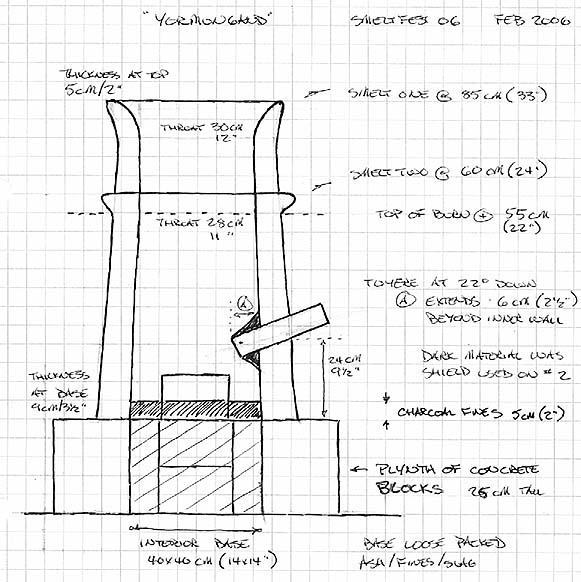Another piece from ongoing discussions on Don Fogg's Bladesmith Forum - Bloomers & Buttons
Jur wrote on 16 January 2013 :
One of my best bloomery results was when I charged the ore straight from the roasting pile into the furnace when it was still red hot. This could explain some of the lower shaft furnaces. Anyone else tried this before?
Some of us here have experimented with different furnace layouts and builds.
There is a relationship between your furnace design and the 'best possible' air volume. Tuyere placement also comes into this, as it will define the shape of the effective heat zone at the bottom of your furnace. That air (oxygen) volume will both ignite a certain amount of charcoal, and produce a certain volume of reactive gases. Both volume and placement are important influences on the quality of the final iron bloom.
If your furnace is BIGGER than the effective 'ball of chemistry' - then there is no actual reduction of the iron oxide occurring at the very upper part of your furnace stack.
What *is* happening is that the materials involved in the smelt (both ore and charcoal) are 'pre-heating', so more or less flash straight into reduction once they hit the heat zone and available reaction gasses.
(Clear as mud - right?)
So, Jur, your mention of lower shaft furnaces is the key to your suggestion.
I think those of us who have build 'medium shaft' furnaces have noticed that there is a significant increase in efficiency. Adding even 10 cm extra in stack height can really increase bloom yield measured against charcoal consumption. The ore is being heated in this upper zone.
So, I think (as much as my brain works) you have hit on a possible way to improve the workings of low shaft or bowl furnaces. (Those with heat zones effectively *smaller* than what might be possible through ignition.)
 |
| 'Boxed Bowl' - L'Anse aux Meadows 2001 (first smelt) |
One thing though does occur to me:
If you took your ore straight from a roasting fire into the smelting furnace - does that not make breaking the ore for correct particle size just a wee bit difficult?
The correct ore size (depending on type and furnace layout) is one of the major variables for a successful smelt.





















No comments:
Post a Comment